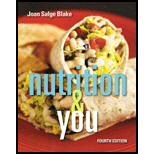
Nutrition & You (4th Edition)
4th Edition
ISBN: 9780134167541
Author: Joan Salge Blake
Publisher: PEARSON
expand_more
expand_more
format_list_bulleted
Concept explainers
Question
Chapter 6, Problem 1.1CYU
Summary Introduction
Introduction: Proteins are made up of the amino acids. Messenger-ribonucleic acid (mRNA) is converted into protein through the process of translation. Proteins form the structure and support the cells. They are coded by genes and form the basis of all living organisms. Some proteins that catalyze the biological reactions are as called enzymes that
Expert Solution & Answer
Want to see the full answer?
Check out a sample textbook solution
Students have asked these similar questions
t
References
Aa -
aly. A
♡
F
Mailings Review
33.
1
34.
Y
Paragraph
View
Help
Tell me what you want to do
AaBbCcDc AaBbCcDe AaBbC AaBbCc AaB =
1 Normal 11 No Spac... Heading 1 Heading 2
Title
5
... 3. ...
29. Lipids are examples of
30. List 3 types of lipids that are components of cell membranes.
31. are solid at room temperature, while are liquid at room temperature.
32. Describe the structure of a phospholipid molecule.
4. ... 15
are the workhorse molecules of the cell, with functions such as
are the monomeric units of proteins and they are connected by
35. Proteins that are inactivated due to being hot folded correctly are said to be
way to cause it.
(hydrophobic/hydrophilic) molecules.
36. Nucleic acids exist in 2 primary forms,
(made of nucleotides
(made of nucleotides
and__).
37. The nucleic acid in the nucleus of a cell, known as the genetic material is
and
bonds.
Styles
6
and
is one
and) and
TRUE OR FALSE (DO THEM ALL)
1. Lipids have similar elemental components as carbohydrates but contains more energy because that ratio is greater for oxygen.
2. Usually, an animal will drink water twice the amount of feed that it will eat.
3. The deficiency symptoms of Selenium may be associated or similar with vitamin E deficiency.
4. A technology in animal breeding that dates back in 1770s is considered the most useful and applicable strategy of increasing the genetically superior genes from proven sires.
A. Palpation
B. Artificial insemination
C. Cryopreservation
D. Embryo transfer
True or false
1. proteins can be converted to fats in the LIVER.
2. Carbohydrates, proteins, and fats are not accounted as the macromolecules.
3. Bile is the digestive juice from the liver.
4. Amino acids are the hydrolysis product.
5. Carbohydrates cannot be converted to glucose.
Chapter 6 Solutions
Nutrition & You (4th Edition)
Knowledge Booster
Learn more about
Need a deep-dive on the concept behind this application? Look no further. Learn more about this topic, health-nutrition and related others by exploring similar questions and additional content below.Similar questions
- The basic building blocks for protein are a. glucose units. b. amino acids. c. side chains. d. saturated bonds.arrow_forwardI. MULTIPLE CHOICE: Please choose the BEST ANSWER to the followingquestions below. 10. Fatty acids containing double bonds are found in ________. a. polysaccharides. b. proteins. c. saturated lipids. 11. The fatty acid with the IUPAC name of hexadecanoic acid is ________. a. lauric acid. b. myristic acid. c. palmitic acid. d. stearic acid. 12. Which of the following has the least number of saturated fatty acids? a. Coconut oil b. Corn oil c. Lard d. Palm oilarrow_forwardO 4G lI. 11:۳9 Regarding carbohydrates, which of the following is correct: O a. Carbohydrates are responsible for storing and implementing the genetic information in the cell. O b. The building blocks of carbohydrates are small molecules called fatty acids. O. Plants produce an energy storage polysaccharide called cellulose. O d. Polysaccharides are formed by linking hundreds or thousands of monosaccharides together in a dehydration synthesis reaction. إضافة شرح... ( امونarrow_forward
- True or false 1. Polysaccharides consist of a small number (around 3 to 10) of monosaccharides linked together. 2. Raffinose is found in broccoli, and asparagus. 3. The glucose that we consume primarily comes from animals. 4. Starch, glycogen and cellulose are examplles of polysaccharidesarrow_forwardPlease don't provide handwritten solution.... I need both solution pleasearrow_forwardI need help please.arrow_forward
arrow_back_ios
SEE MORE QUESTIONS
arrow_forward_ios
Recommended textbooks for you
 Nutrition: Concepts and Controversies - Standalo...Health & NutritionISBN:9781305627994Author:Frances Sizer, Ellie WhitneyPublisher:Brooks Cole
Nutrition: Concepts and Controversies - Standalo...Health & NutritionISBN:9781305627994Author:Frances Sizer, Ellie WhitneyPublisher:Brooks Cole NutritionHealth & NutritionISBN:9781337906371Author:Sizer, Frances Sienkiewicz., WHITNEY, ElliePublisher:Cengage Learning,
NutritionHealth & NutritionISBN:9781337906371Author:Sizer, Frances Sienkiewicz., WHITNEY, ElliePublisher:Cengage Learning,

Nutrition: Concepts and Controversies - Standalo...
Health & Nutrition
ISBN:9781305627994
Author:Frances Sizer, Ellie Whitney
Publisher:Brooks Cole

Nutrition
Health & Nutrition
ISBN:9781337906371
Author:Sizer, Frances Sienkiewicz., WHITNEY, Ellie
Publisher:Cengage Learning,
